 On October 20, the U.S. base at al Tanf in southern Syria was hit by drones and rockets in a “deliberate and coordinated attack,” Central Command said. Iran appeared to be responsible for the attack, which included up to five drones carrying explosives, U.S. officials told the Associated Press. The drones were Iranian but were launched from within Syria, officials told CBS News.
On October 20, the U.S. base at al Tanf in southern Syria was hit by drones and rockets in a “deliberate and coordinated attack,” Central Command said. Iran appeared to be responsible for the attack, which included up to five drones carrying explosives, U.S. officials told the Associated Press. The drones were Iranian but were launched from within Syria, officials told CBS News.
The U.S. military was warned about the attack and evacuated some 200 troops on C-130 military transport planes. Only about two dozen remained at al Tanf but were unharmed, although bomb fragments were found near sleeping quarters and guard posts, according to Fox News. The Pentagon did not specify the source of the warning.
Fars News Agency, an Iranian outlet tied to the Revolutionary Guards, attributed the attack to the “Allies of Syria,” a little-known group of pro-Iran militias formed in 2015. The “Allies of Syria” was attacked, reportedly in an Israeli airstrike, near Palmyra in central Syria on October 13. In a statement, it claimed that the attack came from the direction of al Tanf and vowed “very harsh” retaliation. Israel has reportedly carried out hundreds of strikes on Iran-linked targets in Syria since the civil war broke out in 2011.
Update
— Nafiseh Kohnavard (@nafisehkBBC) October 21, 2021
Military source familiar with Al Tanf just confirmed to me that these pictures are from the base.
US troops at Al Tanf, Syria became under drone & rocket attack last night.
Will be cautious until CENTCOM releases its imagery too.
Pix were received by @AuroraIntel pic.twitter.com/CJDUuI663L
On October 31, President Joe Biden warned that the United States would respond to Iranian drone strikes and other moves against U.S. interests. “With regard to the issue of how we’re going to respond to actions taken by them against the interests of the United States — whether they’re drone strikes or anything else — is we’re going to respond,” he said at a press conference after the G20 summit in Rome.
Since 2016, the U.S.-led coalition against ISIS has used the base to launch operations and train Syrian opposition groups fighting the jihadists. The United States had more than 2,000 troops in northeast Syria to support the Syrian Democratic Forces, a Kurdish-led militia opposed to the regime of President Bashar al Assad, at the peak in 2017. U.S. troops remained at al Tanf, a remote outpost controlled by Syrian opposition forces, even after ISIS lost its last territory in 2019. As of October 2021, about 900 U.S. troops were stationed in Syria, around 200 at al Tanf.
Al Tanf is located on the Baghdad to Damascus highway and near the border where Syria, Iraq and Jordan converge. The American presence has become caught up in the wider regional conflict because the base blocks a key route reportedly used by Iran to supply its network of allies and proxies in Syria and Lebanon. Since 2004, Iran has provided drones—or parts, blueprints and training to produce drones—to proxies in at least four locations: Lebanon, Iraq, Yemen, and Gaza. Iran and its allies have also operated drones in Syria.
The last major attack by Iran on U.S. forces was on Jan. 8, 2020. The Revolutionary Guards launched 15 to 22 short-range ballistic missiles at the Ayn al Asad Air Base and a military base near Erbil in Iraq, which both also housed U.S. forces. At al Asad, U.S. forces were alerted by early warning systems hours in advance and had time redeploy forces or shelter in bunkers. But the missiles damaged or destroyed several facilities, and more than 100 U.S. service members were diagnosed with traumatic brain injuries. The missiles "were intended to cause structural damage, destroy vehicles and equipment and aircraft, and to kill personnel," said General Mark A. Milley, chairman of the Joint Chiefs of Staff. The attack was retaliation for the U.S. killing of Iranian General Qassem Soleimani, the head of Iran’s elite Qods Force, on Jan. 3, 2020.
